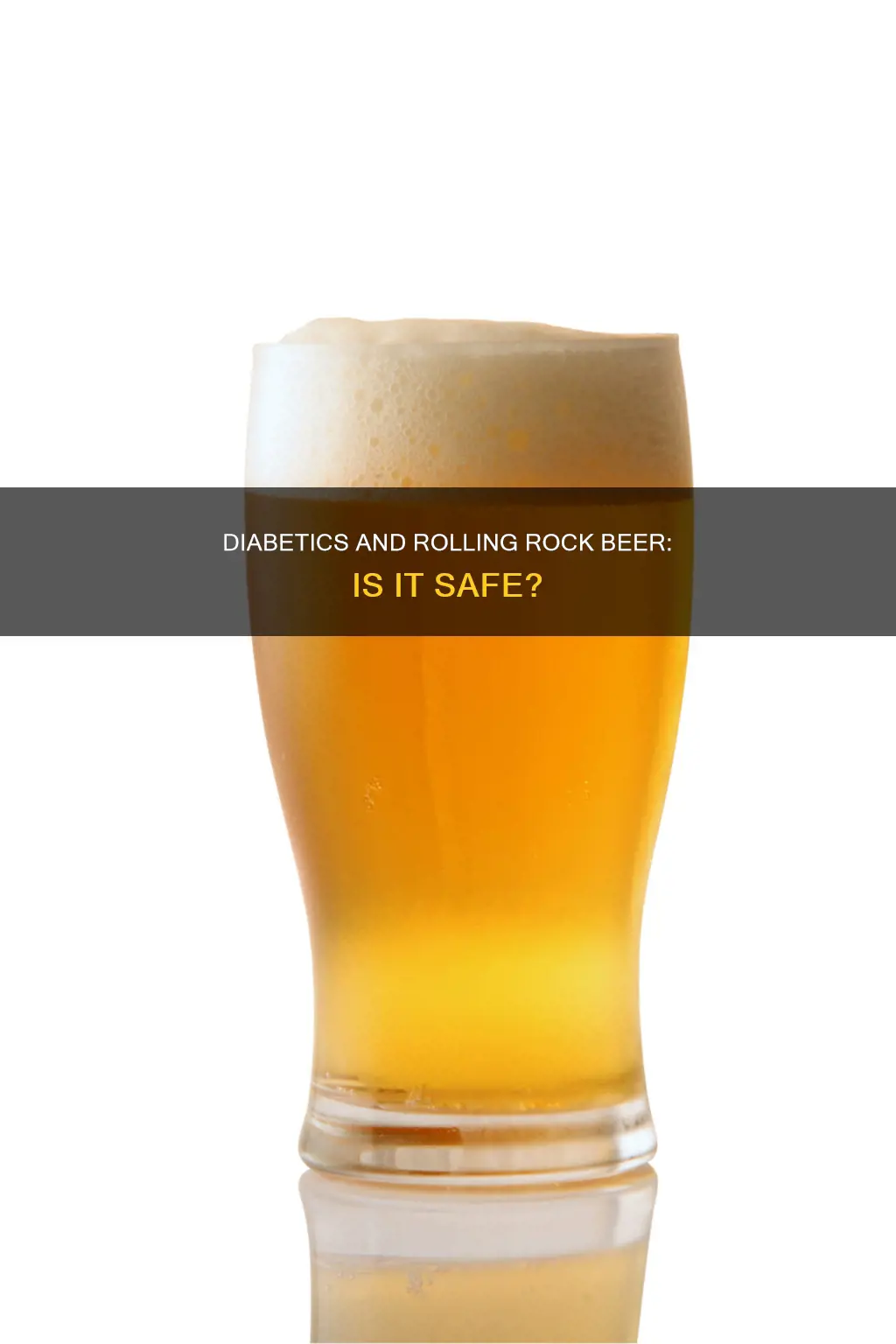
People with diabetes do not need to cut alcohol out of their diets, but there are some safety considerations to keep in mind. The liver prioritizes clearing alcohol from the body, which can slow down carb metabolism and lead to low blood sugar (hypoglycemia). This can be dangerous for people with diabetes, especially if they are on insulin or other anti-hyperglycemic medications. To prevent hypoglycemia, it is recommended to not drink on an empty stomach and to keep an eye on blood sugar levels.
Rolling Rock is an American lager with 4.4% ABV, launched in 1939 by the Latrobe Brewing Company. It is brewed with a distinctive soft local water in large glass-lined tanks. It is known for its smooth taste and is considered a regional beer from the VA, PA, and Ohio area.
So, can diabetics drink Rolling Rock beer? While there is no universal rule for drinking with diabetes, it is important for diabetics to be mindful of their blood sugar levels and drink in moderation. Rolling Rock has a relatively low ABV compared to some other alcoholic beverages, but it is still important for diabetics to monitor their blood sugar and follow their doctor's recommendations when consuming any type of alcohol.
What You'll Learn

Is Rolling Rock beer suitable for diabetics?
It is important to note that people with diabetes do not need to cut alcohol out of their diet. However, there are some safety considerations to be aware of. Firstly, alcohol competes with the liver's ability to make glucose when blood sugar is low, which can lead to dangerously low blood sugar levels for up to 24 hours after drinking. This is especially important for those on insulin or other anti-hyperglycemic medications. Additionally, alcohol can impair judgement, making it harder to recognise low blood sugar levels.
To prevent hypoglycaemia, it is recommended to not drink on an empty stomach and to keep food nearby while drinking. It is also important to monitor blood sugar levels during and after drinking. The recommended alcohol consumption for people with diabetes is the same as for the general population: no more than one drink per day for women and up to two drinks per day for men. "Binge drinking" is strongly discouraged.
When it comes to beer, the carbohydrate content can vary depending on the type. "Light" beers tend to have the fewest carbs, usually five grams or less per serving, and are also lower in alcohol content. Hoppy craft beers like IPAs and stouts tend to be much higher in carbs, typically 15 grams or more per serving.
Rolling Rock is an American lager with an alcohol content of 4.4% ABV. It is described as having a smooth taste and being less bitter than some other beer brands. While the exact carbohydrate content of Rolling Rock is not readily available, as a lager, it typically falls in the range of beers with higher carbohydrate content. Therefore, while Rolling Rock beer may be suitable for diabetics in moderation and when consumed with food, it is important to be mindful of its potential impact on blood sugar levels.
In summary, Rolling Rock beer may be suitable for diabetics when consumed in accordance with general alcohol consumption guidelines and when paired with food to prevent hypoglycaemia. However, it is important for diabetics to monitor their blood sugar levels when drinking any type of beer, including Rolling Rock, to ensure their blood sugar levels remain within a healthy range.
Beer and UTI: What You Need to Know
You may want to see also

How does beer impact blood sugar levels?
Beer can impact blood sugar levels in several ways. Firstly, beer contains carbohydrates, which can raise blood sugar levels. The amount of carbohydrates in beer varies depending on the type, with “light” beers having fewer carbs, usually five grams or less per serving, and craft beers like IPAs and stouts containing significantly more, typically 15 grams or more per serving.
Secondly, alcohol in beer interferes with the liver's ability to release glucose into the bloodstream, which is necessary to maintain normal blood sugar levels. When you drink alcohol, your liver prioritises breaking it down over releasing glucose, leading to a drop in blood sugar levels. This effect can last for hours after your last drink, and the more drinks consumed, the higher the risk of hypoglycemia. Therefore, drinking on an empty stomach or when blood sugar levels are already low is not recommended as it can further increase the risk of hypoglycemia.
Thirdly, alcohol stimulates appetite, which can lead to overeating and affect blood sugar control. Alcoholic drinks are also high in calories, making weight loss more difficult. Over time, excessive alcohol consumption can reduce the effectiveness of insulin, resulting in higher blood sugar levels.
Additionally, alcohol may affect judgement and willpower, leading to poor food choices and potentially increasing blood sugar levels. Alcohol can also interfere with the effectiveness of oral diabetes medications and insulin, further impacting blood sugar control.
It is important to note that the impact of beer on blood sugar levels can vary depending on the amount consumed and individual factors such as overall health and medication use. Therefore, it is always a good idea for people with diabetes to consult their doctor to understand the risks involved and to follow recommended consumption guidelines.
Drinking Beer on Kauai Beaches: What's Allowed?
You may want to see also

What are the best alcoholic drinks for diabetics?
People with diabetes do not need to cut alcohol out of their diet. However, there are some safety considerations to keep in mind. Firstly, alcohol competes with your liver’s ability to make glucose when your blood sugar is low, which can lead to dangerously low blood sugar up to 24 hours after drinking. Secondly, alcohol can cloud your judgement, so you may not realise that your blood sugar is low. Thirdly, certain diabetes medications can increase your risk of hypoglycaemia, and excessive alcohol consumption further affects that risk. Therefore, it is important to consult with your doctor about whether and how you can safely drink alcohol.
If you choose to drink alcohol, it is recommended to stick to light or low-carb beers, red or white wine, distilled spirits, or low-carb cocktails.
Light or Low-Carb Beers
Light beers are brewed to lower their calorie and carbohydrate content. Most regular beers contain about 15 grams of carbohydrates per 12 ounces, whereas light beers contain about half that amount, and maybe as few as 2 grams per 12-ounce serving. Some light beer options include Michelob Ultra Pure Gold, Beck’s Premier Light, and Yuengling Lager Light.
Red or White Wine
In moderation, red wine has heart-healthy benefits and provides antioxidants that may help lower the risk of heart disease. A standard 5-ounce serving of red or white wine has about 120 calories, nearly all of which come from alcohol, not carbohydrates. Dry sparkling wines, such as Champagne, prosecco, or cava, are also good options. However, it is best to avoid sweet wines, such as Port, Riesling, Moscato, Sauterne, and ice wine, as these contain more sugar.
Distilled Spirits
Distilled spirits or hard liquors contain few to no carbohydrates. Options include gin, rum, vodka, or whiskey, which have 0 grams of carbohydrates per 1.5-ounce serving. However, the carbohydrate content of your drink may vary depending on what you mix the liquor with. It is best to avoid mixing liquor with sugary juices or sugar-containing soda, as this can cause a spike and then a dip in blood sugar levels.
Low-Carb Cocktails
When it comes to cocktails, it is best to opt for low-sugar options. For example, a martini, made by mixing gin or vodka with dry vermouth in a 2-to-1 ratio, has only 0.2 grams of total carbohydrates in a 4-ounce drink. Another option is a vodka soda, made by combining vodka and club soda or seltzer. If you want a flavoured version, use flavoured sparkling water instead of flavoured vodka, which may contain added syrups.
Drinking Beer After Donating Blood: What You Need to Know
You may want to see also

What are the risks of drinking with diabetes?
Drinking alcohol can be risky for people with diabetes, and it's important to be aware of the potential dangers. One of the biggest concerns is hypoglycemia, or low blood glucose. This can occur when alcohol is combined with medications commonly used to treat diabetes, such as insulin and sulfonylureas. The liver, which is responsible for stabilising glucose levels, prioritises metabolising alcohol over maintaining blood glucose levels, which can lead to hypoglycemia. This is more likely to occur when drinking on an empty stomach, so it's recommended to snack while drinking.
It can be difficult to distinguish between hypoglycemia and drunkenness, as they share many symptoms, including slurred speech, drowsiness, confusion, and difficulty walking. Additionally, drinking can impair your judgement, so you may not realise that your blood sugar is low. Hypoglycemia can also occur hours after your last drink, especially if you've been exercising, so it's important to monitor your blood sugar levels regularly while drinking and up to 24 hours after you stop.
Alcohol can also interfere with your medication regimen. It can be easy to forget to take your medications or to mix up the dosage when you've been drinking. Additionally, drinking can cause you to lose track of your food intake, which is important for managing diabetes. Alcoholic drinks themselves often contain carbohydrates and are high in calories, which can contribute to weight gain over time.
While moderate drinking may offer some health benefits, such as improved blood glucose management and insulin sensitivity, excessive drinking can lead to higher blood glucose levels and an increased risk of chronic diseases such as heart disease, liver disease, and kidney disease. Therefore, it's important for people with diabetes to drink in moderation, following the general guidelines of no more than one drink per day for women and up to two drinks per day for men.
Vegan Beer: What's in Your Pint Glass?
You may want to see also

How many carbs are in a typical beer?
People with diabetes do not need to cut alcohol out of their diet. However, there are some safety considerations to keep in mind. Alcohol competes with your liver’s ability to make glucose when your blood sugar is low, which can lead to dangerously low blood sugar up to 24 hours after drinking.
Beer is typically higher in carbs than other alcoholic drinks like wine or liquor, but the carb content can vary widely depending on the type of beer. "Light" beers have the fewest carbs, usually 5 grams or less per serving. They also tend to be lower in alcohol content. For example, Miller Lite contains 3.2 grams of carbohydrates in a standard 12-ounce can or bottle, compared to 12 grams for the same serving in regular Miller beers. Similarly, Bud Light provides fewer than 5 grams of carbs per serving, while a regular Budweiser contains 10.6 grams.
Hoppy craft beers like IPAs and stouts tend to be much higher in carbs, typically containing 15 grams or more per serving. They also tend to be higher in calories and alcohol content, so it’s best to stick to just one serving.
Regular lagers typically vary in carbohydrate content from about 10 to 15 grams per pint. Some ‘light’ beers may be better and have less than 10 grams of carbs per pint, and some less than 5 grams. Pilsners are thought to have a relatively benign effect on blood sugar.
Stouts, Porters, and Guinness tend to be on the higher end of the carbohydrate spectrum among beers and can have upwards of 20 grams of carbohydrates per pint. There are a wide variety of real ales, covering pale ales through to porters. These will typically have a carbohydrate content of 10 to 20 grams of carbs per pint.
If you are watching your carbohydrate intake, you may want to limit the amount of beer you drink and opt for light beers, which are lower in both calories and carbohydrates.
Beer and Prostate Surgery: What You Can Drink Post-Op
You may want to see also
Frequently asked questions
Yes, diabetics can drink beer, but it is important to do so in moderation and to be aware of how it can affect your blood sugar levels. Beer is a significant source of carbohydrates, so it can impact blood sugar. It is recommended that women have no more than one drink a day and men no more than two.
Rolling Rock is an American lager with 4.4% ABV. It was launched in 1939 and is known for its distinctive branding, which includes the number 33 prominently displayed on the bottle.
Rolling Rock beer has 4.4% ABV, which is within the moderate drinking range for people with diabetes. However, it is important to remember that drinking guidelines are the same for people with and without diabetes: no more than one drink a day for women and up to two drinks a day for men. It is also important to drink in moderation and to be aware of how alcohol affects your blood sugar levels.







